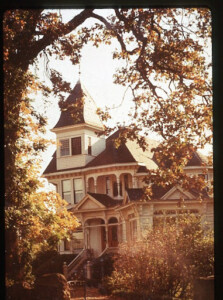Deepwood Estate
This elegant and unique Queen Anne style house was built in 1894 for druggist and land speculator Dr. Luke A. Port. It was one of the designs which helped launch the brilliant career of architect William C. Knighton who later served as Oregon’s first State Architect. He also designed many other public and private northwest showcases, including the Oregon Supreme Court Building (1914) during his nearly 50-year career.
The five-acre estate was originally part of the circa 1889, 220-acre Yew Park subdivision. Although Historic Deepwood Estate is now a part of Bush’s Pasture Park, it was never owned by the Bush family.
The interior of the house features warm golden oak woodwork and original Povey Brothers stained glass windows. The formal, English style gardens were among the first commissions by landscape architects Lord and Schryver. Near the parking lot is the City of Salem’s largest public greenhouse.
Another element of the Deepwood Estate is, as it is known today, the Rita Steiner Fry Nature Trail. The trail winds through native trees, plants and wildflowers along Pringle Creek. The Deepwood Estate and Gardens were individually listed on the National Register of Historic Places in 1973.
Deepwood is the most significant example of landscape architects Elizabeth Lord and Edith Schryver’s Northwest work. It is their only garden design that is open to the public. There are three other superb examples of their designs in the area, but they are associated with private residences.
Deepwood Estate acquired its name from the popular children’s book of the day named The Hollow Tree and Deepwoods Book by Albert Bigelow Paine. It is available at the Salem Public Library.
Researched and written by Paul Porter and Susan Gibby.
This article originally appeared on the original Salem Online History site and has not been updated since 2006.








Leave A Comment